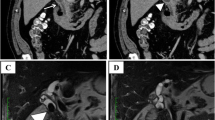Abstract
The mechanisms of fistula formation were analyzed in eight patients with Mirizzi syndrome with biliobiliary fistula. The fistula was type 1 in three patients and type 2 in five, according to the Corlette-Bismuth classification. The apparent mechanisms of fistula formation include inflammation of the gallbladder, its subsequent fusion to the bile duct, and increase in the internal pressure due to either contraction of the gallbladder or multiple stones. However, no predisposing conditions other than a longstanding history of cholelithiasis have been suggested. Differences in the type of fistula are considered to be due to the mode of fusion of the gallbladder to the bile duct, and the size of the perforation, which is apparently determined by the area in contact with the stone.
Similar content being viewed by others
References
Mcsherry CK, Ferstenberg H, Virshup M. The Mirizzi syndrome: Suggested classification and surgical therapy. Surg Gastroenterol 1989;1:219–225.
Corlette MB, Bismuth H. Biliobiliary fistula. A trap in the surgery of cholelithiasis. Arch Surg 1975;110:377–383.
Yip AWC, Chow WC, Chan J, et al. Mirizzi syndrome with cholecystocholedochal fistula: Preoperative diagnosis and management. Surgery 1992;111:335–338.
Mishra MC, Vashishtha S, Tandon R. Biliobiliary fistula: Preoperative diagnosis and management implications. Surgery 1990;108:835–839.
Baer HU, Matthews JB, Schweizer WP, et al. Management of the Mirizzi sndrome and the surgical implications of cholecysto-choledochal fistula. Br J Surg 1990;77:743–745.
Venkatesh Rao PS, Tandon RK, Kapur BML. Biliobiliary fistula: Review of nine cases. Am J Gastroenterol 1988;83:652–657.
Mirizzi PL. Syndrome del conducto hepatico. J Int Chir 1948;8:731–733.
Dietrich KF. Die Hepatikusstenose bei Gallenblasenhals und Zystikussteinen (Mirizzi Syndrom). Bruns Beitr Klin Chir 1963;206:9–22.
Clemett AR, Lowman RM. The roentgen features of the Mirizzi syndrome. Am J Roentgenol 1965;94:480–483.
Sutton JP, Sachatello CR. The confluence stone: A hazardous complication of biliary tract disease. Am J Surg 1967:113:719–722.
Sandblom P, Tabrizian M, Rigo M, et al. Repair of common bile ducts using the gallbadder or cystic duct as a pedicled graft. Surg Gynecol Obstet 1975;140:425–432.
Author information
Authors and Affiliations
Rights and permissions
About this article
Cite this article
Tanaka, N., Nobori, M., Furuya, T. et al. Evolution of Mirizzi syndrome with biliobiliary fistula. J Gastroenterol 30, 117–121 (1995). https://doi.org/10.1007/BF01211386
Received:
Accepted:
Issue Date:
DOI: https://doi.org/10.1007/BF01211386




